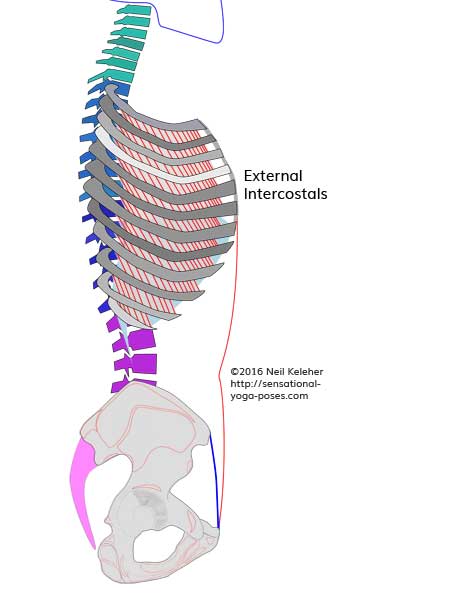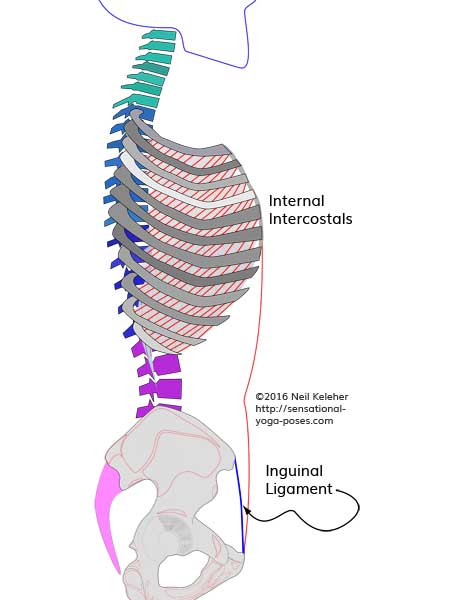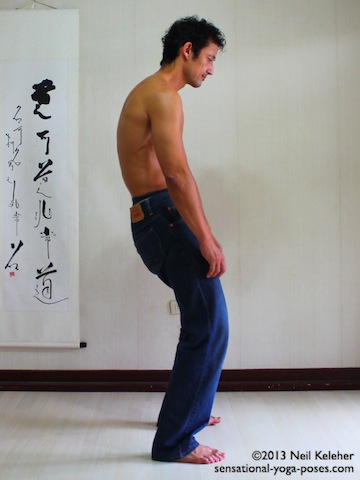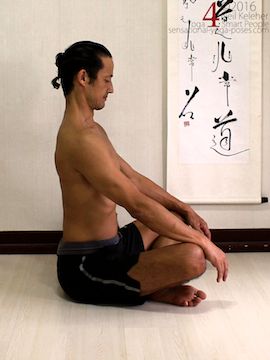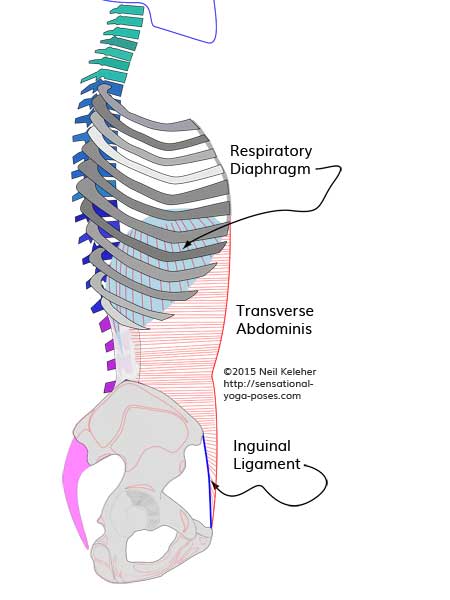Costal Breathing is different from "chest breathing" where a person lifts the entire ribcage and then lowers it. In costal breathing the ribcage expands as well as lifts.
In easy breathing the focus is on bending the spine forwards and backwards while breathing, using the spinal erectors and intercostals together.
While costal breathing can include this method, it can also include a focus on lifting the side and back ribs.
The costal breathing exercises on this page start with easy breathing to give you a feel for your spine and ribcage and then move on to costal breathing variations.
For a more detailed approach to easy breathing read the Easy Breathing Technique.
Anatomy aside one of the reasons that I like this breathing exercise is that it helps improve awareness of the ribcage. It also helps to mobilize it improving flexibility.
And it leads to the ability to stabilize the ribcage which can be helpful when trying to provide a foundation for the shoulders.
It may also provide enough awareness that diaphragmatic breathing is then easier to learn.
This exercise may also improve neck posture and posture in general or make it easier to find good posture and keep it.
This exercise can also be used to help differentiate movements of the chest/ribcage from those of the shoulders. The overall affect is greater awareness of the ribcage as well as the ability to breathe more easily.
Slouching is the starting position for learning easy breathing followed by costal breathing. (It is also a good position to begin your practice of diaphragmatic breathing.)
If you are sitting on the floor, cross legged or kneeling, you can allow your ribcage to sink down and your head to slide forwards. If you are sitting on a chair you can do the same thing.
If you are standing you might need to bend your knees in order to slump.
While Slouching
- Allow your pelvis to tilt back (so that the top of your tailbone moves towards the floor.)
- Allow your spine to bend forwards (so that your back is round) and allow your head to slide forwards and down.
- Look down, like you are trying to see if there is any fluff in your belly button. (Of course if you have an outey, then this probably won't happen.)
Because your lumbar spine is bent forwards you may feel the back of your lumbar spine being stretched. Because your head is hanging down you may feel the back of your neck being stretched. You may also notice the weight of your ribs sinking down.
Relax. Let your head and ribs sink down. Allow your spine to round.
De-slouching (Moving to Slouch Zero)
Slowly sit up tall.
To sit up tall, tilt your pelvis forwards so that your lumbar spine straightens. Feel the front of your ribs lifting up. Pull the back of your head back and up. Draw your chin down towards your chest.
Feel the back of your neck lengthening and your chest opening.
While Sitting Tall
- Pull your head away from your ribcage and lengthen your neck
- Pull your ribs away from your pelvis and lengthen your waist
- Move your ribs away from each other and expand your ribcage.
Initially, each time you inhale focus on pulling your head back and up. Feel your neck lengthening. Relax while exhaling. Once you are comfortable with this, then as you sit up tall feel your neck and also feel your waist as you pull your ribs away from your pelvis. Then work at feeling your neck and waist and also feel your ribs as they open and move away from each other.
See if you can feel all of these points as you inhale. See if you can make them work together so that your inhales and exhales both feel smooth and effortless, like a well oiled machine.
This same method can be used for fixing your posture.
Doing the same breathing exercise as above, focus on feeling the front of your ribcage while you lift and lower. As you lift your ribs focus on expanding the front of your ribcage. Open the spaces between your ribs.
When you exhale allow your ribcage to collapse and sink down, but allow it to collapse slowly!
To open the front of your ribcage more you can focus on bending your thoracic spine backwards while inhaling. You can also work on pulling your chin in and using the front of your neck to pull your chest towards you chin.
Let your ribcage sink down while exhaling.
Once you have the feeling of opening the front of your ribcage then focus on feeling the sides of your ribcage. As I mentioned before, work towards making these breathing actions feel smooth and effortless. And since this is costal breathing, focus on feeling your ribs as the lift and then sink.
To deepen your awareness of the sides of your ribcage, first focus on the sides of the bottom half of your ribcage. As you inhale they swing out to the sides and up (like bucket handles). If your arms are by your sides then your side ribs will push your elbows out as you inhale.
When your relax and exhale your side ribs will move down and in.
When inhaling, you may find it easier to focus on lifting your side ribs as opposed to moving them outwards. However, as you lift them, see if you can feel some slight outwards movement.
Once you can get comfortable with this costal breathing exercise, expand your awareness so that you can feel your upper side ribs (the parts of your ribcage that your shoulders cover) also. You may find that this part of the ribcage moves upwards more than it does outwards.
Focus on feeling the entire side (left and right) of your ribcage moving up as you inhale and down as you exhale. Try to feel (or imagine you can feel) each individual rib.
Next, move your awareness to the back of your ribcage and feel the back of your ribs.
Costal breathing into your back ribs can follow naturally from breathing into your side ribs.
The back of your ribs will naturally lift and lower if you are already "breathing into" the sides of your ribs.
However, you can accentuate the action and increase your sensitivity by focusing on feeling the back of your ribcage.
As you inhale feel the back of your ribs lifting. (The sides of your ribcage move outwards and up at the same time.) As you exhale focus on feeling the back of your ribs sink down.
If this is difficult, then focus on bending your spine backwards using your spinal erectors as you inhale. Feel the contraction of your spinal erectors and try to use this same contraction to lift your back ribs. Then relax while exhaling.
One of the nice things about opening up the back of your ribcage is that you may find it makes it easier to bend your thoracic spine backwards. At the same time, bending backwards can make it easier to lift your back ribs. So try to do both actions together.
So now you can focus on lifting your back ribs as you inhale. You're side ribs will automatically lift. As you lift your back ribs, lengthen your neck. This will open the top of your chest. Then bend your spine backwards.
See if you can lift your back ribs while bending your spine backwards at the same time. Your front ribs will then automatically lift.
Relax while exhaling.
Another action or variation of costal breathing that you can experiment with is bending your spine forwards while inhaling into your back. Normally its pretty easy to open your chest while inhaling. Now do the opposite and open your back.
The feeling is like you are bulging your back open as you inhale. The backs of your ribs can feel like they are lifting as well as expanding while you do this.
While exhaling, you de-bulge your back and let your ribs sink down.
You may find that your can make your inhales quite deep with this variation of costal breathing.
Possibly its because the lungs are bigger at the back than they are at the front. (The bottom of the lungs slope down from front to back.) And also the back of the ribcage is larger than the front. And it can be easier to "bulge" the back of the ribcage because it is more flexible (because of the spine) than the front of the ribcage.
So, if you can breathe into the back of your ribcage more when you inhale, you may find that you can take more air in.
A variation of back breathing is to first breathe into your back and then when you are about half way full then breathe into the front of your ribcage. This can have a wave like affect on your spine.
Breathing into your back ribs you bend your spine forwards. Then as you fill the front of your ribcage your spine straightens and perhaps bends back a little.
You can use this variation to help lift your arms. First breathe into your back ribs. Spread your shoulder blades as you do so. Then as you breathe into your front ribs use the lifting action of your front ribs to help swing your arms forwards and even up. Then relax your arms down (slowly) as you exhale.
Ultimately any type of breathing where the ribs are used could be labeled costal breathing. Costus is the Latin word for ribs. When you breath "using your ribs" you are actually using the muscles between your ribs to change the shape of your ribcage. These "intercostal" muscles work together to change the shape of your ribcage, expanding and contracting it as required.
The external intercostals and the internal intercostals.
Note how they are positioned between and work on adjacent ribs.
When you pay special attention to the back of your ribcage you may be using your Levator Costarum to help lift your ribs. These muscles attach from the spine to the ribs and when contracted pull upwards on the backs of the ribs.
If you bend your spine backwards while costal breathing you are more than likely using your spinal erectors to bend your spine backwards. These muscles run up and down either side of the spine.
The spinal erectors and levator costalis are located quite close together and so by activating your spinal erectors you may find it easier to activate your levator costalis or vice versa.
Another variation of costal breathing is to breathe evenly and simultaneously into the fronts, sides and back of your ribcage.
When doing this, focus on expanding your entire ribcage as you inhale.
Then allow your ribs to sink as you exhale.
Make the movements slow and smooth.
One of the advantages of trying to move smoothly and slowly is that it forces you to feel your body. It also forces you to develop better control. It can also feel very good.
If you use both your ribs and your diaphragm while breathing then you can expand your lungs from all sides, and contract them from all sides, helping you to have fuller inhales and fuller exhales.
